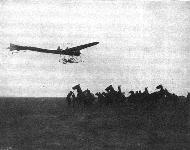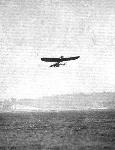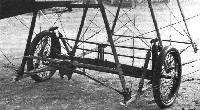Jane's All The World Aircraft 1913
AVIATIK. Autemobil & Aviatik A.G., Mulhausen i.E. Established 1910. Capacity: 100 a year.
1912. 1912. 1913. 1912-13.
Monoplane. Biplane. Racing Hydro-
biplane. biplane.
Leng......feet(m.) 26? (8) 36 (11) 29? (9) 36 (11)
Spa.......feet(m.) 39 (11.80) 52? (16) 52? (16) 62-1/3 (19)
A.....sq. feet(m?) 258 (24) 517 (48) 517 (48) 597 (56)
Weight,
...total, lbs.(kgs) 1146 (520) 1323 (600) 1234 (560) 1653 (750)
..useful, lbs.(kgs) 661 (30) 882 (400) 882 (400) 661 (300)
[** Text has (k.m.)- should surely be (kgs.)??]
Motor.........h.p. 100 Argus 100 Argus 100 Argus 100 Argus
Speed,
...max. m.p.h.(km.) 68? (110) 56 (90) 62 (100) 52 (80)
...min. m.p.h.(km.) ... ... ... ...
Endurance.....hrs. 5 6-8 7-8 4-5
Number built
during 1912 6 20 4 3
Remarks.--The monoplanes are constructed under Hanriot license.
Показать полностью
L.Opdyke French Aeroplanes Before the Great War (Schiffer)
Deleted by request of (c)Schiffer Publishing
Also in 1910, on 16 January at the Brussels IXieme Salon de l'Automobile, de l'Aeronautique, du Cycle et des Sports, 2 new Hanriots were shown, each with the now-typical long covered fuselage, rectangular wings, and 6-legged undercarriage. One featured 2 kingposts and a single long fin and trapezoidal rudder; the other had the V-pylon and a forward kingpost, and a small pointed rudder fitted to a peaked fin. Both had control wheels on each side of the cockpit.
The same year, a prolific one for the firm, appeared the Grand Monoplan with 2-3 seats; perhaps it was designated Type II. Also offered for sale was the Libellule (dragonfly), a smaller single-seater with a 45-50 hp Clerget, also with the pointed fin and rudder. A similar machine with a 50 hp Clerget and rounded wingtips and a trapezoidal pylon was marked VI. One of these was reworked for Pequet with a Gnome and different undercarriage legs.
In 1911 the firm built a military version, with rounded wingtips, a single seat and a 4-legged undercarriage. A second military type was entered in the Concours Militaire; this one had a big 100 hp Clerget, 2 pairs of close-set wheels in a 6-legged structure, and could seat 3 to 5 people. The pylon was of the familiar trapezoidal form, but with an inverted arch for the rear support.
After the Concours, Ponnier, a designer for Hanriot, bought out the firm, which took the name of the new owner. The Ponniers will be described under their own name, though some of these also appeared in later Hanriot catalogs.
Показать полностью
Журнал Flight
Flight, August 6, 1910
Doings at Brooklands.
ALTHOUGH a series of good prizes were offered by the Brooklands Club for competition among the flyers there during the racemeeting on Monday, the high wind which prevailed until 6 o'clock rendered it advisable for all machines to remain under cover. At 6 o'clock, however, the improved conditions brought out Blondeau on Mrs. Grace Bird's Farman biplane, and he successfully completed fifteen rounds of the course in 36 mins. 47 secs., the distance covered being about 25 miles. Cordonnier made a start on the Hanriot monoplane, but he had only covered a short distance when he came down again, and before he could stop the machine it ran down the bank of the Wey to the water. It was, however, soon rescued with the aid of some Boy Scouts. Mr. L. D. Gibbs. was also trying his Sommer biplane, but did not make any lengthy flight.
Flight, December 3, 1910
THE HANRIOT MONOPLANE.
WHEREVER it has been seen, the Hanriot monoplane has invariably attracted attention, and more often than not received favourable criticism of its shipshape appearance. And, now that it is about to be brought to the fore in this country under the regis of a powerful syndicate, the interest that it has awakened in the capacity of a mere "visitor" at some of our flight meetings is likely to mature in a more practical form among those who have an ambition to fly. There are many points of distinct originality in the Hanriot design and construction, but it is not always that these features in question are appreciated individually as such by those on whom their tout-ensemble makes a good impression. First and foremost there is, of course, the wooden boat-shaped hull, that naturally strikes everyone at first sight as the outstanding departure from orthodox practice, but there is also the "A" type frame that supports this body upon the wheel and skid chassis, and those who attended the previous Paris Aero Show will doubtless remember that a similar feature of construction characterised the Hanriot monoplane of last year. Those who were not actually present at that Exhibition, but who care to turn up their first volume of FLIGHT, will find our own illustration and description of the machine on page 740 of our November 20th issue, 1909. It was, in our opinion, one of the most interesting constructional details that the Paris Aero Show brought to light. Simple in design and construction, strong in principle, it formed a clever solution to a problem that it has not been easy to turn into a really neat job; that the method has been generally appreciated may be judged from the fact that several other makers of monoplanes subsequently adopted the essential features of this design.
There is also a good deal to be said in favour of the boat body on the Hanriot monoplane, and quite apart from any intrinsic merit that this system of construction may possess on its own account, there is a distinct advantage in the system in that it dispenses with the use of a tremendous amount of wire that would otherwise be necessary for bracing some equivalent girder member. We have no objection to wire in principle, and unquestionably it is a wonderfully strong and light method of building up a frame; but on the modern aeroplane there is so much wire that any method of reducing the amount is welcome on this score alone. Wire bracing needs some little attention, for it should at least be periodically inspected, and if more wire is used than is absolutely necessary it seems to us that there is just the likelihood that it may provoke carelessness with regard to its proper maintenance. By the use of a boat body, the Hanriot monoplane is clear of all wire for which a suitable substitute can be provided, and those wires that do remain take on, in consequence, an added importance that should ensure their proper attention. It may, perhaps, seem a little outside the zone of present day conditions to bring forward a criticism of this description, but it must after all be remembered that manufacturers essentially hope to obtain a fairly wide sale for their machines, and many aeroplanes are quite likely to pass into the hands of users who will not always realise the necessity of persistent attention to small mechanical points while their chief object is to get up into the air. The wider and the more rapid the development of aviation, the more is this likely to be the case - as it has been, for instance, in connection with motor cars - so that in considering the construction of machines, it is necessary, even now, to take note of features such as these, because of the influence that they may have on future design.
The boat body of the Hanriot monoplane is constructed on the lines of a racing skiff, and it is well known that this form of construction produces a very strong and very light girder. The top of the body is entirely decked in, except for a little cockpit containing the pilot's seat. Immediately behind the pilot's seat the deck is thickened so that it is safe for the pilot to stand thereon when mounting and dismounting. No wires of any description interfere with free access to this part of the machine. Three steel strips form a kind of cradle for the support of the body on the "A" type chassis frame, the strips being bolted to the inclined struts of the frame and passing under the body as shown in one of the accompanying sketches. Steel strips are also employed for lashing the main spars of the wings to the body, and it will be observed in the same sketch how these spars are mounted on blocks and lashed in place as described. The spars are not horizontal, but are set at an angle to one another, the "dihedral" being 7 ins., that is to say, the extremities of the wings rise 7 ins. above the shoulders. The spars in question are 3 ins. deep and 1 1/2 ins. wide, and they are constructed on the three-ply principle instead of being cut from one piece of wood. This is a departure from common practice that we have not noticed elsewhere, and in view of the criticism that has been levelled against the supposed tendency of monoplane-wing spars to buckle, this method of construction will doubtless arouse interest. The laminae of the spars are arranged vertically, but again bearing in mind the matter just referred to, it is conceivable that some use might be made of this principle with horizontal laminae to strengthen the spars against the forward pressure; it is the end thrust on a machine that is the difficult force to meet. The vertical forces can be more readily provided for because the presence of the propeller in no way interferes with any system of bracing that may be preferred. In the Hanriot monoplane it is worthy of note that the rear spars of the main wings are individually trussed by a diamond bracing, each spar being fitted with a vertical cross strut in the centre and the four extremities being tied by diagonal wires. The rear spars are hinged to the frame so that they can rock for wing warping, and the hinge pins are tied together by a steel tube so as to relieve the body of undue strain.
The control of the Hanriot monoplane is mainly interesting on account of the use of two levers, one under the control of the pilot's left hand and the other under the control of his right hand. That on the left moves sideways and operates the wing warping, that on the right moves to and fro and controls the elevator that forms a hinged extension of the tail plane. In front of the pilot's seat is a pivoted cross-bar that can be rocked by the pressure of his feet. This controls the rudder, which is mounted between the halves of the elevator. The fixed tail-plane on the Hanriot monoplane is quite flat, and consists of a sheet of fabric tightly stretched by the aid of a couple of transverse spars. The rear portion of the tail plane is deflected a little below the line of the leading portion, to which it has a relative, although small, angle of incidence.
Well forward of the main planes is the engine, which on this machine is an 8-cyl. 40-h.p. E.N.V. This is mounted in the bows of the boat body, and is also partly supported by the struts of the "A" frame, a pair of which are situated immediately beneath the motor. The tractor-screw, which is direct-driven by the engine, is 2.1 metres is diameter, and 1.2 metres in pitch. When at rest on the ground, the machine is carried by a pair of pneumatic-tyred wheels in front and by a light trailing-skid behind. The wheels are mounted on a steel axle that is reinforced by a wood batten and mounted in vertical guides, so that it has a considerable upward travel. Suspension is effected by elastic springs anchored to the main skids and attached to the upper end of a column that rests upon the axle itself.
The construction of the axle is shown very clearly in one of our photographs, in which it will be observed that the system represents a very strong but rather rigid form of construction ; rigid, that is to say, so far as lateral stiffness is concerned, for the vertical play permitted by the guides is considerably in excess of that usually obtained with the ordinary rubber attachment of the axle to the skids. The clearance is enough, in fact, to enable the wheels to rise up so high as to enable the weight to be taken directly on the skids in the event of a very severe bump. Like everything else in the Hanriot design, solidity seems to be the keynote of its construction.
It is with a machine of this type that some very satisfactory flights have been made at Brooklands recently.
Flight, February 18, 1911
HANRIOT WING CONSTRUCTION.
No part of the modern monoplane is of more importance or less visible than the framework of the wing, and the accompanying sketches illustrating the Hanriot wing-construction will doubtless interest many of our readers. The outstanding features of the system are the two main spars, that in front being a very substantial boxgirder, 3 ins. in depth by 1 1/2 ins. in width. It will be observed from the detail sketch that the sides of the girder are secured to the top and bottom pieces by copper rivets after being glued. The method of letting the steel shackle-plates for the tie-wires into the spar is also interesting and is clearly shown in the sketch. The rear spar of this machine is built up on the three-ply principle and is of smaller dimensions. It is, of course, obvious that the front main-spar is also fundamentally of three-ply construction, the only difference being that it has a hollow core, which thus introduces the box-girder principle. The construction of the ribs is clearly illustrated in the sketch. It will be observed that the top and bottom laths have their camber maintained by light distance-pieces at intervals, and that the fabric is supported between the ribs, which are situated about 12 ins. apart by light laths arranged parallel to the spars. The front of the plane is formed by a sheet of thin aluminium, which makes a light, smooth, and blunt entering edge. This entering edge is situated about a foot in front of the main spar, which is itself 3 ft. 4 ins. in front of the rear spar. Behind the rear spar the rib extends to a distance of about 2 ft. 7 1/2 ins. The front main-spar is attached rigidly to the body of the machine by steel straps that embrace the spar and the wedge-shaped blocks on which it rests. These wedge-shaped blocks are supported by a transverse girder in the body and give the set of the dihedral angle to the wings.
For additional security a pair of long bolts tie this support to the bottom of the body. The rear spar is merely hinged to the body, as it necessarily requires a flexible attachment to facilitate the warp. Each wing weighs complete with fabric 48 lbs.
Flight, January 6, 1912.
PARIS AERO SHOW.
Aviatik.
CONSIDERING that only three weeks elapsed between the commencement of the construction of this handsome monoplane and its appearance in all the glory of its resplendent nickel fittings on the opening day of the Salon, it must be observed that the ability to accomplish such a performance speaks well for the excellence of personnel and organisation at the Aviatik works.
Although built under Hanriot licence, there is little to acquaint a casual observer of the fact except that the general disposition of its respective parts is very similar, and that the design of the tail is nearly identical.
The main body is constructed like the hull of a racing skiff, and at its forward extremity is disposed the motor - an Aviatik of 100-h.p. Petrol is fed by pressure from a tank under the passenger seat to an auxiliary tank slung from the cabane, and from this point the feed is by gravity. The landing gear is closely allied to the Henry Farman design, but has the peculiarity that all four wheels are mounted on one common axle. The struts supporting the skids are hollow, with the exception of the front pair. It is a noticeable feature that both German machines at the Salon, the Albatross and the one at present under review, are equipped with hand-brakes in order that they may be brought to rest as soon after landing as possible. In cross-section the wings closely resemble those of the Nieuport. Mounted directly in front of the pilot is the control wheel, which is arranged vertically at the upper end of a pivoted vertical column. The elevation is governed by a to-and-fro movement, warping by rotating the wheel laterally.
Principal dimensions, &c. :-
Length 31 ft.
Span 41 ,,
Area 275 sq.ft.
Weight 990 lbs.
Speed 70 m.p.h.
Motor 100-h.p. Aviatik.
Price L1,000.
Показать полностью



































